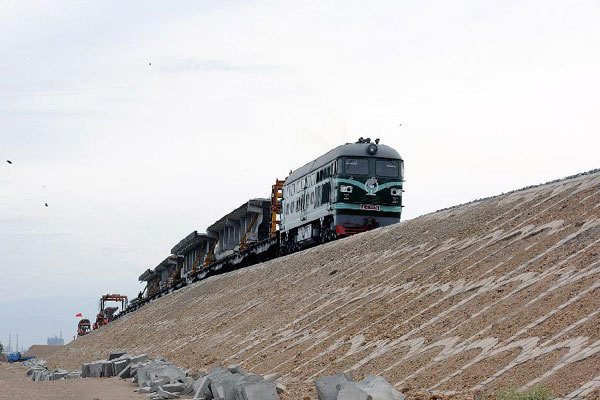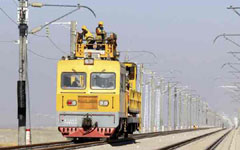 |
|
A train transports rail laying materials for the construction of Hami-Lop Nur railway line in northwest China's Xinjiang Uygur Autonomous Region, June 19, 2012. [Photo/Xinhua] |
Xinjiang eyes bigger role in economic belt with broader transport networks
Eager to enhance its developing strength, the Xinjiang Uygur autonomous region plans to build more international rail routes on the Silk Road economic belt.
The plans are part of a bid to expand exports as Xinjiang races to catch up with other established competitors in China's western and central regions.

|
|
 |
"We are planning to offer two regular block train services this year. The first train will depart from Urumqi to Mersin in southern Turkey via Kazakhstan, Turkmenistan and Iran this year," said Peng. "Another train service to Moscow will be launched by the end of this year."
With shorter transport times and lower freight costs, more than a dozen Chinese cities have discovered that international rail lines linking many parts of China to Central Asia and Europe can help improve regional connectivity and trade on the Eurasian Land Bridge and today's Silk Road Economic Belt.
Since 2010, major Chinese cities, including Chengdu, Chongqing, Xi'an, Zhengzhou, Wuhan and Yiwu have launched weekly or monthly block train services to European and Central Asian destinations. This is part of China's effort to turn its inland resources and labor-rich cities into international trade hubs.
Because Xinjiang borders eight countries and is geographically much closer to Central Asia and Europe than other parts of China, the region is capable of establishing a "flexible rail transportation network throughout the Silk Road Economic Belt, to further stimulate Xinjiang's economic growth and create more jobs", Peng said.
Countries in Central Asia and Eastern Europe, including Kazakhstan, Turkmenistan, Poland and Belarus, are also willing to build new platforms for broader trade as well as cultural and technological cooperation with China and other countries along the route.
